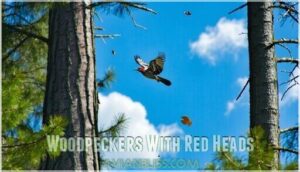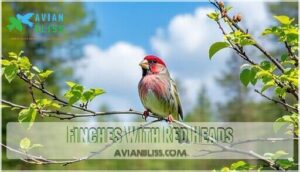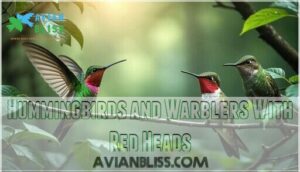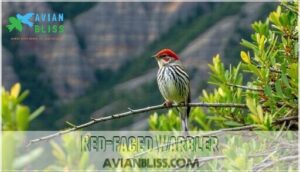This site is supported by our readers. We may earn a commission, at no cost to you, if you purchase through links.

Male Northern Cardinals flash their brilliant crimson crowns year-round, while House Finches sport rusty-red caps that vary in intensity.
Woodpeckers like the Red-headed and Downy species use their colorful headgear for territorial displays and mate attraction.
These vibrant hues come from carotenoid pigments in their diet – think of it as nature’s way of saying "you are what you eat."
Some species, like Western Tanagers, only show red during breeding season, making identification trickier.
The intensity and pattern of red coloring often reveals age, sex, and health status in fascinating ways.
Table Of Contents
- Key Takeaways
- Red Headed Birds Overview
- Birds With Red Heads
- Red Headed Bird Species
- Red Headed Bird Conservation
- Red Headed Bird Identification
- Frequently Asked Questions (FAQs)
- What does a red headed finch look like?
- What birds have red heads?
- Are red head birds parasitic?
- What does a red head bird mean?
- What birds have red feathers?
- What types of birds have red heads?
- Why do some birds have red heads?
- Are red headed birds found in all regions of the world?
- Are red headed birds only found in adult birds?
- Are red headed birds protected species?
- Conclusion
Key Takeaways
- You’ll find over 25 red-headed bird species across North America, including cardinals, finches, woodpeckers, tanagers, and hummingbirds, each with unique identifying features beyond just their red coloring.
- Red head coloring serves important purposes – males use bright crimson plumage for territorial displays and attracting mates, while the intensity varies based on diet, age, and health status.
- You can distinguish between similar species by examining bill shapes, body size, wing patterns, and behavioral cues, since many birds share red head markings but differ in other key features.
- Many red-headed birds face conservation challenges from habitat loss, climate change, and urban development, making citizen science programs and habitat preservation efforts crucial for their survival.
Red Headed Birds Overview
You’ll find red-headed birds across North America displaying vibrant crimson crowns, caps, and facial patches that serve as striking identification markers and breeding signals.
Vibrant red crowns flash through North American forests like living jewels, marking nature’s most striking avian ambassadors.
These colorful species range from tiny hummingbirds with needle-like bills to massive woodpeckers with chisel-shaped beaks, each adapted perfectly for their specific ecological niche.
Physical Characteristics of Red-Headed Birds
You’ll spot red-headed birds by their vibrant head plumage ranging from deep crimson to bright scarlet.
Their feather patterns vary dramatically: cardinal birds show solid red coloring, while tanagers mix red with black wing colors.
These eye-catching creatures display diverse beak shapes – from woodpeckers’ chisel-like bills to finches’ cone-shaped beaks.
Tail lengths differ too, with some species sporting long, notched tails and others displaying shorter, squared ends.
The conservation of red headed birds is essential for maintaining ecosystem balance and biodiversity, which are critical for the survival of these red headed birds.
Species Classification and Distribution
You’ll find red headed birds across diverse Geographic Range territories, from North America’s woodlands to tropical regions worldwide.
Species Diversity includes over 25 types spanning multiple families: red headed woodpeckers dominate eastern forests, cardinal birds thrive in brushy areas, and tanager birds prefer canopy habitats.
Migration Patterns vary substantially—some remain year-round while others travel thousands of miles seasonally.
Habitat Distribution reflects each species’ Conservation Status and survival needs.
Habitat, Diet, and Behavior
Red headed birds showcase fascinating adaptations across diverse environments.
Nature’s crimson crowns tell stories of survival, adaptation, and the endless dance between beauty and function.
You’ll observe these species thriving in specific niches, from woodpeckers hammering dead trees to finches cracking seeds with specialized beaks.
Their diverse lifestyles include:
- Nesting Habits – Cardinals build cup-shaped nests in dense shrubs, while woodpeckers excavate cavities in tree trunks
- Food Sources – Tanagers hunt insects in canopy tops, finches prefer sunflower seeds at feeders
- Migration Patterns – Some species like Western Tanagers journey to South America, others remain year-round
Social Behavior varies dramatically among red headed birds.
During Breeding Seasons, males display vibrant plumage to attract mates, while species like House Finches form flocks outside nesting periods.
Birds With Red Heads
You’ll discover over 25 bird species that showcase stunning red head plumage, from the common Northern Cardinal to the rare California Condor.
These vibrant birds span multiple families including woodpeckers, finches, tanagers, and hummingbirds, each with unique identifying features that’ll help you spot them in your backyard or local park.
Woodpeckers With Red Heads
Woodpeckers showcase remarkable diversity in Red Head Types, from the fully crimson Redheaded Woodpecker to the orange-tinged Redbellied Woodpecker.
These redheaded birds use their Red Cap Function for species recognition and territorial displays. The RedBreasted Sapsucker demonstrates specialized Woodpecker Diet adaptations, drilling precise sap wells.
Red Plumage Genetics vary substantially among species, with some showing sexual dimorphism. Unlike many birds, most woodpeckers don’t follow traditional Woodpecker Migration patterns, remaining year-round residents where food sources persist.
The Red-headed Woodpecker’s unique appearance is characterized by its flying checkerboard pattern, making it a distinctive species among woodpeckers with a notable flying ability.
Finches With Red Heads
Several finch varieties display stunning red headed birds characteristics that’ll catch your eye.
House Finch males sport raspberry-red caps and breasts, with their Red Plumage intensity varying based on Finch Diet – carotenoid-rich foods create brighter colors.
Purple Finches show wine-red heads, while Cassin’s Finches feature crimson crowns.
These red headed finches produce distinctive Bird Songs during breeding season.
Their Nesting Habits involve cup-shaped structures in trees or shrubs, with Finch Migration patterns varying by species and region.
Tanagers With Red Heads
Among red headed birds, tanagers showcase some of nature’s most striking summer transformations.
Summer Tanagers sport brilliant red plumage year-round, while male Scarlet Tanagers develop their famous scarlet heads during breeding season.
Western Tanagers display orange-red face patches that make identification easier.
These species demonstrate fascinating tanager migration patterns, traveling thousands of miles between breeding and wintering grounds.
Their distinctive bird song helps birders locate them in dense canopy cover.
Hummingbirds and Warblers With Red Heads
These aerial acrobats showcase stunning Red Head Feathers during breeding season, with males displaying brilliant gorgets for territorial displays.
Anna’s Hummingbirds feature pink-red crowns, while Ruby-throated species dominate eastern regions.
Red-faced Warblers stand out with vibrant crimson faces year-round, contrasting their mountain forest habitats.
The Red-faced Warbler’s behavior is characterized by its role in insect capture methods that aid in maintaining ecological balance.
- Anna’s Hummingbird – Only U.S. species with pink-red crown extending beyond throat
- Ruby-throated Hummingbird – Males show vivid ruby gorgets during Hummingbird Migration seasons
- Rufous Hummingbird – Coppery-red heads distinguish these feisty territorial defenders
- Red-faced Warbler – Bright red faces help identify these high-elevation insectivores
- Beak Shapes vary dramatically – needle-like bills for nectar versus pointed warbler bills for insects
Red Headed Bird Species
You’ll discover six standout red-headed bird species that showcase the incredible diversity of these vibrant creatures across North America.
From the melodious House Finch to the striking Northern Cardinal, each species offers unique identification challenges and behavioral quirks that make birdwatching both rewarding and occasionally frustrating, with the Northern Cardinal being a prime example of a species with notable diversity.
Cassin’s Finch
You’ll often spot Cassin’s Finch in mountainous regions where males showcase tiny red crests that catch sunlight beautifully.
These North American birds prefer high-elevation coniferous forests and display fascinating Finch Migration patterns following seasonal food availability.
Their distinctive Beak Structure efficiently cracks sunflower seeds at feeders.
| Feature | Male | Female |
|---|---|---|
| Crown | Bright red crest | Brown with subtle pink |
| Body Size | 6.4 inches length | Similar size |
| Wingspan | 9.8-10.6 inches | 9.8-10.6 inches |
| Plumage | Pinkish-brown with rosy streaking | Streaked brown overall |
| Bill | Stout, cone-shaped | Stout, cone-shaped |
Their Bird Songs include melodic warbles and calls that echo through pine forests.
Nesting Habits involve building cups in conifer branches using twigs and grass.
Feather Care includes regular preening to maintain their distinctive coloring, which intensifies during breeding season.
House Finch
House finches are year-round residents across most of North America, making them excellent subjects for studying finch behavior and plumage variation.
Unlike other finches with seasonal finch migration patterns, these adaptable birds stick around your backyard feeders all year.
Males sport rosy-red heads that intensify with a carotenoid-rich diet, while females display brown streaking.
Their relaxed nesting habits include building nests in hanging plants, mailboxes, or building ledges.
Bird feeding enthusiasts love house finches because they’re not picky eaters, readily accepting sunflower seeds and nyjer.
Northern Cardinal
You’ll find Northern Cardinals year-round across their Northern Habitat range from eastern United States to the Southwest.
Males showcase brilliant Red Plumage while females display subtle reddish tinges.
These red headed birds don’t follow typical Bird Migration patterns, staying put through winter.
Their Cardinal Diet includes seeds, fruits, and insects.
Cardinal Songs feature clear whistles like "birdy-birdy-birdy."
Key Northern Cardinal features:
- Males completely red with black face mask
- Females brownish-tan with reddish wings, tail, and crest
- Prominent orange-red conical bill perfect for cracking seeds
- Year-round residents showing no seasonal migration
- Distinctive crest gives them a regal appearance among cardinals
Downy Woodpecker
You’ll spot Downy Woodpeckers year-round across most North America, making them among the most common red headed birds at backyard feeders.
These pint-sized woodpeckers sport distinctive black-and-white barred backs with males displaying bright red patches on their heads.
Their Downy Diet consists mainly of insects, though they’ll readily visit suet feeders during winter months when natural food sources become scarce.
Western Tanager
Western Tanagers are like living flames dancing through western forests.
You’ll recognize males by their striking orange-red faces and yellow bodies during breeding season, while females sport subtler olive-yellow plumage.
These red headed birds migrate thousands of miles from Alaska to Central America.
Researchers study their bird species to understand migration patterns.
- Western Migration: Follow ancient flyways spanning from Canada to Guatemala annually
- Tanager Diet: Feast on wasps, bees, and insects caught mid-flight like aerial acrobats
- Bird Song: Produce distinctive robin-like calls that echo through mountain forests
- Feather Care: Maintain vibrant plumage through careful preening and dust bathing
- Breeding Habits: Build cup-shaped nests high in coniferous trees for protection
Red-faced Warbler
Red-faced Warblers break free from typical warbler patterns with striking crimson heads marked by bold black stripes.
These red headed birds nest on mountain slopes, choosing ground-level Nesting Sites under dense vegetation.
Unlike red headed woodpecker or scarlet tanager species, Red-faced Warblers show minimal Song Variations between regions.
Males display vibrant Feather Color year-round, while females sport duller tones.
Migration Patterns take them from southwestern U.S. breeding grounds to Mexican wintering areas, where Habitat Loss increasingly threatens their populations.
Red Headed Bird Conservation
Understanding red-headed bird conservation helps you protect these vibrant species for future generations.
You’ll discover that habitat loss, climate change, and human development pose serious threats to many of these colorful birds, though conservation efforts and citizen science programs offer hope for their survival.
Protected Species
Several red-headed bird species face serious conservation challenges.
The red headed woodpecker is classified among Endangered Birds due to habitat loss, requiring urgent Conservation Efforts.
Species Preservation programs protect the scarlet tanager, summer tanager, and red crossbill through Wildlife Management initiatives.
Habitat Protection measures safeguard nesting sites for these vibrant species.
You’ll find red headed finch populations also benefit from coordinated conservation strategies.
Understanding bird conservation status is essential for developing effective protection plans.
Cultural Significance
Throughout history, you’ll find red headed birds woven into human culture like vibrant threads in a tapestry.
Cardinals represent hope and spiritual messages in Christianity, while Native American folklore associates the scarlet tanager with transformation.
The red headed woodpecker appears in Audubon’s masterpieces, becoming an iconic symbol of American wilderness.
These red headed icons carry deep symbolic meaning across cultures.
Ecology and Habitat Preservation
Beyond forest borders, red headed birds depend on diverse ecosystems for survival.
You’ll find these species thrive when woodland ecology remains intact, supporting Conservation Efforts and Ecosystem Balance.
Consider these essential preservation priorities:
- Native plant restoration – supports insect populations that feed red headed woodpecker families
- Dead tree maintenance – provides vital nesting cavities for cavity-dwelling species
- Corridor creation – connects fragmented habitats, enabling seasonal migration patterns
- Invasive species removal – protects native food sources from aggressive competitors
Wildlife Preservation programs focus on maintaining Biodiversity Protection through strategic Habitat Loss prevention.
Bird habitat preservation requires understanding how red headed birds interact with their environment.
Bird conservation biology shows these species serve as indicator species – their presence signals healthy woodland communities.
Threats to Red Headed Bird Populations
Throughout history, red headed birds have faced mounting challenges that threaten their survival.
Habitat Loss through deforestation eliminates 18 million acres annually, while Climate Change shifts migration patterns by 2.3 days per decade.
Pollution Effects reduce insect prey by 40%, and building collisions kill one billion birds yearly.
| Primary Threat | Impact on Red Headed Birds |
|---|---|
| Habitat Fragmentation | Reduces nesting sites by 58% in critical areas |
| Invasive Predators | Increases nest failure rates by 50% |
| Urban Development | Causes 1 billion collision deaths globally |
Red Headed Bird Identification
Identifying red-headed birds correctly requires attention to specific field marks beyond just the red coloring.
You’ll need to observe bill shape, body size, wing patterns, and behavioral cues since many species share similar red head markings but differ dramatically in other features.
Key Identification Features
Spotting red headed birds becomes easier when you focus on specific field marks that separate one species from another.
Each red headed bird displays unique combinations of features that help you make positive identifications in the field. Understanding a bird’s identification guide is essential for accurate classification.
Here are the key features to examine:
- Head Markings – Look for the extent and shade of red coloration, plus any contrasting patterns like the scarlet tanager’s black eye stripe or the red headed woodpecker’s clean white collar
- Beak Shapes – Notice whether you’re seeing a finch’s thick seed-cracking bill, a woodpecker’s chisel-like tool, or a warbler’s thin insect-catching point
- Plumage Patterns – Check wing tips, tail markings, and overall feather colors that distinguish a redhead duck’s chestnut crown from a red headed finch’s rosy wash
Similar Species
You’ll encounter many lookalike birds when identifying red-headed species.
Red headed woodpecker and Red-bellied Woodpecker share eastern ranges but differ in head coverage.
Summer tanager males stay red year-round while scarlet tanager males show seasonal color variations.
Red crossbill’s unique beak shapes distinguish it from typical red headed finch species.
Watch for subtle feather patterns and species mimicry tricks.
Understanding the red headed sparrows can help with accurate identification of similar species.
Regional Variations
Regional variations in red headed birds reflect fascinating Geographic Patterns shaped by Climate Effects and Habitat Diversity.
You’ll notice distinct differences as these species adapt to local conditions along their Migration Routes.
- Northern cardinal populations show brighter red coloration in warmer southern regions
- Red headed woodpecker displays size variations, with larger birds in northern territories
- Scarlet tanager develops deeper red hues in eastern forests versus western populations
- Summer tanager exhibits Regional Adaptations in bill size based on local prey availability
Age and Sex Differences in Red Headed Birds
When identifying red headed birds, you’ll notice striking differences between ages and sexes.
Juvenile birds display noticeably duller red plumage compared to vibrant adults, while males typically showcase more extensive red coloration than females.
These variations help with species identification and understanding mating rituals.
| Characteristic | Juvenile | Adult Male | Adult Female |
|---|---|---|---|
| Red Intensity | 40-60% less vibrant | Brightest coloration | Muted tones |
| Plumage Extent | Limited red patches | 25-50% more red | Reduced coverage |
| Behavioral Traits | 30% less territorial | Dominant displays | Nesting focused |
| Survival Strategy | Camouflage protection | Mate attraction | Parental care |
Color dimorphism serves evolutionary purposes – bright males attract mates while subdued females avoid predators during nesting.
Sex roles become apparent through these plumage variations, making field identification easier once you understand these patterns.
Frequently Asked Questions (FAQs)
What does a red headed finch look like?
You’ll recognize finches with red heads by their cone-shaped bills and colorful crowns.
Male House Finches sport rosy-red faces, while Purple Finches display bright crimson caps that’ll catch your eye instantly.
What birds have red heads?
Like nature’s crowns marking avian royalty, you’ll spot red-headed species everywhere.
Cardinals, finches, woodpeckers, tanagers, and hummingbirds all sport crimson caps.
Males typically show brighter reds than females, especially during breeding season.
Are red head birds parasitic?
Most red-headed birds aren’t parasitic.
They’re independent creatures who build their own nests and raise their young.
However, some cowbirds with reddish heads practice brood parasitism, sneakily laying eggs in other birds’ nests.
What does a red head bird mean?
Nothing’s more enchanting than spotting these crimson-crowned beauties!
When you encounter red-headed birds, you’re witnessing nature’s bold statement.
These species showcase vibrant plumage that signals territory, attracts mates, and demonstrates health—they’re evolutionary success stories.
What birds have red feathers?
You’ll spot vibrant red feathers on Northern Cardinals, Scarlet Tanagers, House Finches, and Red-headed Woodpeckers.
These birds use their crimson plumage for courtship, territory defense, or just to stand out—nature’s way of adding some flair!
What types of birds have red heads?
Picture nature’s crown jewels scattered across the sky – you’ll spot cardinals, woodpeckers, finches, and tanagers flaunting crimson caps.
These feathered monarchs include House Finches, Red-bellied Woodpeckers, and Northern Cardinals ruling your backyard kingdom.
Why do some birds have red heads?
You’ll find that red heads in birds serve as powerful signals for mate selection and territorial displays.
Males often sport vibrant crimson crowns to attract females and warn competitors away from their turf, with vibrant crimson crowns being a key feature.
Are red headed birds found in all regions of the world?
Red-headed birds aren’t distributed worldwide equally – you’ll find about 70% concentrated in the Americas. These colorful species adapt to specific climates, with tropical regions hosting the most diverse populations globally.
Are red headed birds only found in adult birds?
No, juvenile birds often display different head coloration than adults.
Young birds typically develop their characteristic red head plumage through molting as they mature, with males usually showing brighter reds than females.
Are red headed birds protected species?
Protection status varies by species.
Many are protected under the Migratory Bird Treaty Act , making it illegal to kill or harm them without permits.
Check local regulations for specific species protection levels.
Conclusion
Spotting red headed birds transforms any ordinary birdwatching experience into an absolutely thrilling treasure hunt that’ll keep you captivated for hours.
You’ve now got the tools to identify over 25 stunning species, from brilliant cardinals to striking woodpeckers.
Remember, red coloring intensity varies with diet, age, and season, so don’t expect textbook perfection.
Keep your field guide handy, watch for behavioral cues, and trust your observations, as these crimson-crowned beauties are waiting to reward your patience with unforgettable sightings, making for a truly thrilling treasure hunt.
- https://en.wikipedia.org/wiki/Redhead_(bird)
- https://wildlife-species.canada.ca/species-risk-registry/virtual_sara/files/cosewic/srRed-headedWoodpecker2018e.pdf
- https://digitalcommons.odu.edu/cgi/viewcontent.cgi?article=1198&context=biology_fac_pubs
- https://www.audubon.org/field-guide/bird/cassins-finch
- https://www.allaboutbirds.org/guide/Red-headed_Woodpecker/overview















